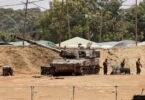WASHINGTON (Defensenews): When the Pentagon in October war-gamed the first iteration of its new strategy, “without overstating the issue, it failed miserably,” said the vice chairman of the Joint Chiefs, Gen. John Hyten. In a fictional confrontation with China, the military aimed to do what it has been doing for the last 20 years, but better ― and that was the problem.
“An aggressive red team that had been studying the United States for the last 20 years just ran rings around us, and they knew exactly what we were going to do before we did it ― and they took advantage of it,” Hyten said. “Imagine what our actual competitors have been doing for the last 20 years, with probably even more focus, with larger numbers. So we had to take a step back and look broadly and say, ‘Okay, what do we miss?’”
The result is the new, new Joint Warfighting Concept, which Hyten essentially rolled out to the defense industry on Monday. It’s meant to tee up swift-moving technological innovation and to define how the U.S. will fight future wars, and Hyten asked industry to sound off when the the military’s bureaucracy gets in the way.
The remarks came at the National Defense Industrial Association’s own roll-out, of its Emerging Technologies Institute, whose stated mission is to promote the advanced technologies it deems essential to the country’s success. Announced in April, its executive director Mark Lewis is a former defense acquisitions official.
More than a year in the making, the Pentagon’s new joint war-fighting concept includes directives to the Joint Requirements Oversight Council on four focus areas: information advantage, joint command and control, joint fires, and contested logistics. They were published in early July.
The JROC serves as an oversight body on the development of new capabilities and acquisition efforts, and Hyten emphasized the directives as way to speed up and empower the armed services’ acquisition efforts ― but they’re also seen as a way to police budget and turf battles between the services, some which have bubbled into public view. Hyten chairs the JROC, made up of the vice chiefs of each military service.
Hyten didn’t mention the Air Force’s beef with the Army’s plans to base long-range missiles in the Pacific per se, but he offered a defense for an all-of-the above approach to fires ― albeit as an “purely aspirational requirement” to be balanced with practical concerns.
“In the Joint Warfighting Concept, fires come from all domains and all services, no restrictions. Why? because [then] the adversary can’t figure out where they’re coming from, and they have no way to defend themselves against that,” Hyten said.
“Now you have to figure out what is affordable, what is practical, what can you do, where can you bring it from, who can have it. All those kinds of things you have to be able to work out, but you should never limit yourself as you begin a concept with what you don’t think you can do.”
As the Pentagon sets out plans to manage and learn from the department’s vast data stores and implement its Joint All-Domain Command and Control concept, Hyten explained how vital data would be to fighting a future war.
“When you’re disconnected from home, disconnected from the structure you have your mission-type orders that tell you exactly what you’re supposed to do, what your rules of engagement are, and you go do that based on the best information that you have, and you fight disconnected,” Hyten said.
“But then you have to figure out in this new world how to pop up again quickly connect to the network, have the information quickly aggregate itself, and then dive back in the threat environment and fire again.”
JROC members typically visit the geographic combatant commands, but the directives came instead on the heels of their trip in April to the innovation elements of the armed services as well as innovative companies. That included small, non-traditional defense firms.
“We saw Boeing, we saw Northrop, we saw all the big companies, but we also saw little companies and companies in Silicon Valley that deliver software every day when I fight to get software delivery every four years,” Hyten said. “The JROC saw that this country still innovates and still innovates, still has the technology advantage over anybody in the world. We’re just not taking advantage of it at the Department of Defense.”
Hyten, who is retiring in November, acknowledged his limited time to implement his new directives personally.
“We’re trying to move fast, and to enable the department to move fast, but I’m running out of time,” he said.






